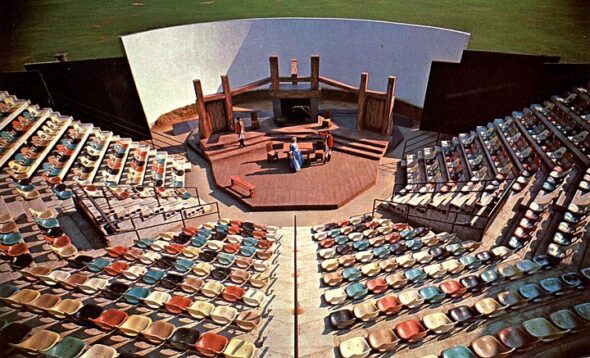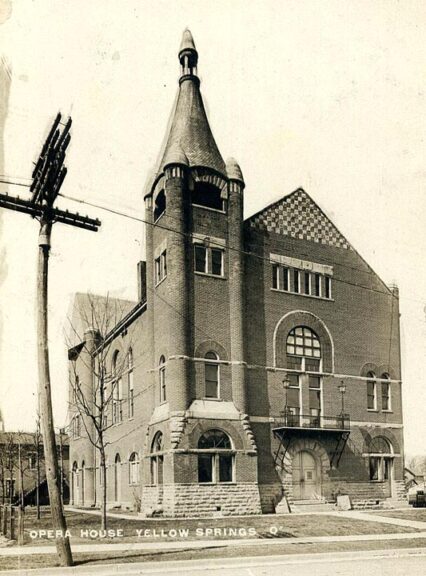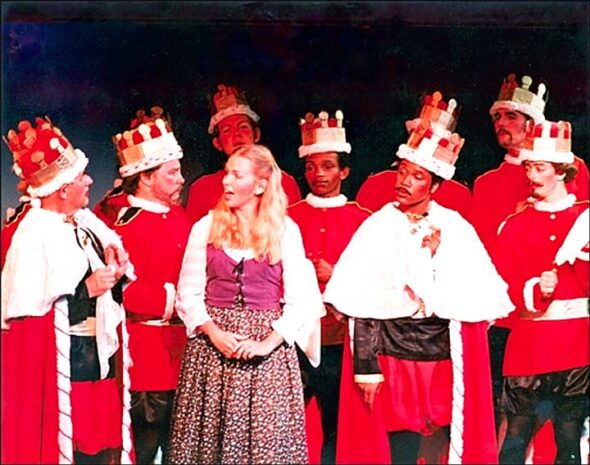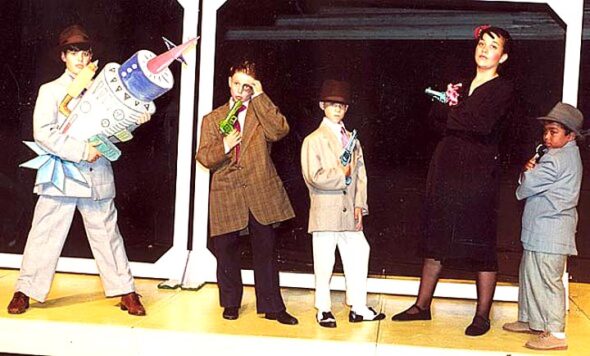
A postcard showing the newly built Antioch Amphitheatre, and its multi-colored seats, which were factory seconds. (Photo Courtesy of Dave Neuhardt)
‘The Timeline Show’— Exhibition tells story of Yellow Springs theater
- Published: October 6, 2020
“This is a town that has never been bothered with shows — it looks rather dull.”
So wrote an “advance man,” who came into the village in 1873 to drum up interest in “Magner & Co’s Great Moral Sensation Show of the Season,” according to a document shared with the News by villager and Yellow Springs Historical Society President Dave Neuhardt.
History tells a different story about Yellow Springs — one about a town that’s had a long, sometimes fraught, but always loving relationship with the theater. That story is being shared with the community by the YS Arts Council, the Arts and Culture Commission and the YS Historical Society in “The Timeline Show,” which opens at the Bryan Center on Jan. 18.
“The Timeline Show,” which is the fourth in a series of art history exhibitions that feature works from the YS Arts Council’s Permanent Collection, will showcase headshots from Center Stage productions taken by the late Ron Siemer; props from Yellow Springs Kids Playhouse productions; a collection of photo collages from Yellow Springs High School and McKinney Middle School plays crafted by Mary Beth Burkholder; and a timeline of theater history in Yellow Springs, compiled by Dave Neuhardt — though Neuhardt stressed in a phone interview last week that it wouldn’t be a complete timeline.
The timeline is mainly comprised of dates Neuhardt has collected from others, like Burkholder, Scott Sanders at Antiochiana, John Fleming, formerly of YS Kids Playhouse and Rebecca Eschliman of the YS Historical Society.
“At this point, I haven’t had a chance to do any actual research,” Neuhardt said, “but we’ll still be working on it and adding to it as time permits.”
The YS Opera House
Yellow Springs’ theater timeline begins in earnest in 1891, when construction of the Yellow Springs Opera House was completed at the corner of Winter and Dayton streets. It was one of many such buildings that sprang up in small towns around Ohio in the late 19th century due to Ohio legislation that allowed villages and townships to issue levies to fund town hall buildings. The Opera House featured town hall offices downstairs and an auditorium upstairs, fit for hosting concerts, speakers, debates and, of course, theatrical performances.
A 1956 News article quotes Bill Baker as saying that he starred in the Opera House’s “first entertainment,” a show called “The Drummer Boy of Shiloh.” The play, written in 1870 by Ohio native Samuel Muscroft, tells the story of a young boy who runs away to join the army during the Civil War, and dies tragically in support of the Union cause. A playbill from a show of that title was shared with the News by Neuhardt; it appears to have been staged in November of 1891, just months after the Opera House opened, and — sure enough — the cast listing includes a “Wm. Baker” as playing the role of “Capt. of Co. G and H.”
In the 1930s, the Opera House became the home of the YS Summer Players and the Antioch Players. By 1945, the town and gown had joined forces as the YS Area Theatre. These were the foundational years of the proverbial golden age of theater in the village, with Antioch professors Meredith Dallas, Arthur Lithgow (father of actor John Lithgow) and Paul Treichler at the helm.

A postcard showing the Yellow Springs Opera House in the first part of the last century. It was located on the northwest corner of Winter and Dayton streets. (Photo Courtesy of Dave Neuhardt)
The Opera House had begun to show its age by that point, and was also plagued by a curious infestation. Writing for the New Yorker in 1954, Paul Rohmann recalled: “I was stage manager of a comedy we had been putting on with particular success … when I heard the laughter in the audience die away. … An energetic bat was circling the theatre. … Round and round he went, louder and louder spoke the actors, while the audience sat pivoting their heads like spectators at an air race … I tried to catch the bat backstage by swiftly lowering the curtain and missed; the audience applauded in a surprised sort of way, and the barnstormer headed out an open fire escape door as the house lights came up.”
By 1949, the YS Area Theatre was producing both a winter and summer season, running plays almost continuously — but this would be the last year that the company would be based at the Opera House. According to News archives, the last show for the company at the Opera House was “The Wise Have Not Spoken,” by Paul Vincent Carroll, directed by famed British actor and director Basil Langton.
The auditorium’s balcony was condemned that year, and though municipal offices still operated downstairs, no further productions were mounted upstairs. News records show that Antioch College considered leasing the theater from the Village in order to justify putting money into repairing the rapidly deteriorating building, but the college declined to do so. After years of trying to decide how to save the historic structure, the Village ultimately decided against it — and the building was demolished in 1960.
Antioch Area Theater and Shakespeare Under the Stars
The loss of the Opera House was not the loss of theater in Yellow Springs, however — in fact, its most historic era had just begun. In the summer of 1952, Dallas and Lithgow produced the first Shakespeare Under the Stars festival, to incredible success. As written in the July 10, 1952, issue of the News: “[the festival] is drawing nationwide attention to Yellow Springs and may make this village a tourist mecca of no small proportions by August.” The newly crowned Queen Elizabeth II, who had ascended to the throne of England earlier that year, sent a letter of commendation to the festival. The Antioch Area Theatre, as it was now known, would produce all 38 of Shakespeare’s plays with both local and nationally known professional actors, holding the final summer festival in 1958.
In 1955, the Antioch Area Theatre made its temporary home in a campus building that had previously housed the foundry that became Morris Bean — the building is now known, appropriately, as the Foundry Theater. After the Shakespeare series ended, Dallas continued to produce at least five plays a year at Antioch with professional actors, like Kelton Garwood, who also starred in TV shows “Rawhide” and “Gunsmoke” and appeared in the “Twilight Zone” episode “Five Characters In Search of an Exit.” There was also Ken Jenkins, an Antioch alum who might be known to younger generations as the aging and curmudgeonly Dr. Kelso from the 2010s TV show “Scrubs,” and who starred in the company’s productions of “Death of a Salesman,” “J.B.” and “Twelfth Night.”
To keep up with the growth and popularity of the program, the college built the Antioch Amphitheater in 1961. As Tony Dallas recounted in an interview last week, the theater’s nearly 600 seats were installed by village kids — including himself.
“The seats were fiberglass, this new material — they were factory rejects, so they were sort of multicolored, [placed] randomly,” he said. “I see that as the heyday of my father’s [Meredith Dallas] artistic blooming — this five-year period in the amphitheater. Yellow Springs was the hub of artistic activity in southern Ohio — especially in theater.”
By the 1970s, however, Meredith Dallas had retired, and the college struggled more and more to support the theater program financially. It closed in 1984, but reopened in 1991 after student protests and continued in 1994 under the direction of Antioch alumna Louise Smith until the college’s 2008 closure. In 2014, three years after the college reopened, the theater program moved into the Foundry Theater, where it continues to hold student productions.
Center Stage
While the ’70s and ’80s may have seen the end of professional theater in the village, those decades saw the emergence of a robust era of community theater with the birth of Yellow Springs Center Stage in 1971.
The Antioch Area Theater before it had braved all the plays of Shakespeare, but Center Stage took a different tack, bringing popular theater to village audiences by mounting all the comic operas of Gilbert and Sullivan, directed by Jean Hooper. As Rebecca Eschliman, a longtime Center Stage member, wrote in the YS Historical Society blog: “The run of Gilbert and Sullivan started in 1972, the second summer of Center Stage’s existence in John Bryan Community Center with a production of ‘The Mikado’ and finished in the summer of 1987 with a production of ‘The Grand Duke.’ … In between those two productions every summer was a much-anticipated production of every other Gilbert and Sullivan operetta, with particular favorites ‘The Mikado’ and ‘Pirates of Penzance’ given revivals.”

In August of 1980, Center Stage performed Gilbert and Sullivan’s “Iolanthe.” Pictured in front, left to right, are Bill Mullins, as Lord Mountsarat; Ronnie Whitmore, as Phyllis; and Raymond Moore, as Lord Tolloler. (Courtesy of YS Historical Society)
Center Stage moved into a space on Dayton Street in 1975 — the space now occupied by Rose & Sal Co. Mercantile — building a black box theater space that would host not only its own productions, but also those of other groups. The company would produce at least a half-dozen shows each year until the ’90s.
“Oh, golly, it was wonderful,” Center Stage veteran Ron Siemer told the News in 2016 — the late Siemer’s collection of headshots from the company’s productions will take center stage themselves in “The Timeline Show.”
“It was real, honest-to-God theater,” he said.
By 1995, both the company and the community at large had begun to slow its use of the Dayton Street space. As reported by the News in 2003: “Center Stage has struggled for a little over five years to attract directors and local support to continue producing quality shows. [Jean Hooper] and other board members said that times have changed and local residents don’t participate in small community theater the way they once did.”
On Aug. 3, 2003, the Center Stage board voted to relinquish occupancy of the building and to sell off all its assets.
As Hooper told the News: “It’s been a lot of fun, and it is with regret that we’re closing … but I think it’s O.K. It’s been a reasonable run, and not a whole lot of theaters make it that long.”
In 2011, villager Kay Reimers revived Center Stage, and the local volunteer company brought community theater to life again with shows like “Threepenny Opera” and “The Crucible,” as well as the 10-Minute Play Festival, which continues annually. The new Center Stage ended its run in 2014, and the YS Theater Company took up the community theater mantle that same year, and continues to produce plays throughout the year.
YS Kids Playhouse
As the original Center Stage was taking its final bow, the curtain was rising on a new — and young — theater program: the Yellow Springs Kids Playhouse, or YSKP. The program was founded in 1995 by John Fleming, and immediately set itself apart from other youth theater programs by featuring annual musical productions and plays written especially for the program — which meant that every year, YSKP’s young cast would star in a world premiere at the Antioch Amphitheater, the new home of the program.
YSKP featured plays written by both nationally known and local playwrights, with music overseen by jazz artist Tucki Bailey for many years. The plays sometimes took on historical subjects, such as in “Endurance,” by Lisa Hunt, about the life of explorer Ernest Shackleton, and “Alice, Although,” about Alice Roosevelt Longworth, penned by Antioch alumna (and YS News freelance writer) Jill Summerville. They also tackled the mythical and fabulous, as in “Superhuman Happiness,” a version of Ovid’s “Metamorphoses,” and “The Conference of Birds,” which was based on a 12th Century Sufi fable by Farid ud-Din Attar; both were adapted by Fleming.

Andrew Beal, Sam Jacobs, David Boyer, Sahara Lawson-Lance and Martin Bakari, in YSKP’s first production, “Dick Tracy: The Musical.” (Submitted Photo)
And sometimes, the plays were a mixed bag of zany comedy, politics and heart — and more than a little prescient. For example, in summer of 1998, the YSKP premiered “Bonanza Valley!” its fourth summer musical, written by then-chair of the Antioch College theater department Louise Smith and choreographed and directed by Fleming. According to the YS News: “‘Bonanza Valley!’” is a musical western whimsically inspired by [two] popular 1960s television series, ‘Bonanza’ and ‘The Big Valley.’ As the play opens, it’s the last episode of the series and the famous ranch is about to be sold for real estate, unless Heartright and his sons can stop the famous developer, Donald Trumpmall.” Trumpmall’s last words in the play were, “I’m going to run for president!”
John Fleming served as creative director for YSKP until 2014, before passing the torch to Ara Beal. YSKP took a hiatus after its 2017 season, producing no shows last year, but announced in November that it would return to the stage this summer — with a reprise of “Bonanza Valley!”
Theater in the schools
As the YS Area Theatre became Antioch Area Theatre, and as those gave way to Center Stage and then to YSKP, there was one institution that kept producing shows on its own schedule, whenever it could: Yellow Springs Schools. Especially in the years when professional theater was at its height, the productions of the village middle and high schools were given short shrift by the local paper of record — the first mention of a high school production that can be found in the News archives is Bryan High’s production of “Daphne” in 1945, which was given only a few lines. Some years, the productions seem not to have been mentioned at all.
Things improved in terms of News coverage in 1951, when Jan Lehman wrote a review of Bryan High’s production of “Rest Assured” by Donald Payton. Lehman didn’t pull any punches, writing: “The play was no strain upon anybody’s intellect. It wasn’t even very funny. … Our primary criticism is the selection of so trite a script. We suggest that the Curtain Pullers depart from the tried and not-so-true collection of high school plays, and try something with a little more punch.”
YSHS and McKinney eventually took this advice to heart, and by the 1980s, were consistently producing spring musicals like “Fiddler On the Roof,” “Big River” and “The Wiz.” In the early ‘90s, YSHS began staging its annual one-act plays, with works written, directed and acted by students. These productions had more “punch” than perhaps reviewer Lehman could have predicted: In 2008, the one acts were the cause of controversy when then-school district Superintendent Norm Glismann forbade student Peter Keahey from performing his play, “Cat Calls,” without considerable edits, as Glismann objected to the play’s use of innuendo. The controversy led to a villagewide conversation about censorship in the arts and in the schools; Glismann left his position as superintendent the next year, telling the News that he didn’t feel like he was a good fit in the village.
“I have professional and personal values that had to be put on the back burner too often,” he said.
In 2004, villager Mary Beth Burkholder began shouldering some of the burden of documenting the efforts of local middle and high school thespians; that year, she created several photo collages of the schools’ productions, documenting back to 1998, as part of a fundraiser for the school’s all-volunteer theater association. Burkholder continued to create the collages for display after that; in talking to the News last week, she estimated that she spent around four to six hours on each collage, and she would hang them up at the Foundry Theater or Mills Lawn — wherever the production happened to be held that year — for students to reminisce over.
“What was fun was when the new one would go up, she said. “Some of those kids had graduated by that point, but they’d come back and say, ‘Oh, the new poster’s up! We have to go see the show!’”
Burkholder continued making the collages well after her own children had graduated, but eventually stopped making them in 2017. Burkholder’s collages will be on display as part of “The Timeline Show.”
“They were a nice archive of the shows, and a lot of people told me how much they loved them,” she said. “I enjoyed doing it.”
*“The Timeline Show” will be on display Jan. 18 through June 30, in the Rose Wing of the John Bryan Community Gallery, on the Bryan Center’s second floor. An opening reception will be held Friday, Jan. 18, 6–8:30 p.m., with live music from Scott Lindberg from 6 to 7 p.m. At 7 p.m., Tony Dallas will present “Meredith Dallas and the Early Years of Antioch Theatre,” a talk and slide show. Refreshments will be offered.
2 Responses to “‘The Timeline Show’— Exhibition tells story of Yellow Springs theater”
The Yellow Springs News encourages respectful discussion of this article.
You must login to post a comment.
Don't have a login? Register for a free YSNews.com account.














The Senior Class plays of the 1970s and 1980s era bring back a lot great memories: West Side Story, the Wiz, Oklahoma, Pippin, and so on. True community events. YSHS had a lot theatrical and vocal talent in those days. The plays even gave those who lacked either (or both) an opportunity to participate.
Wow! I get the YS News so how did I miss this? This is a great article–with a couple of corrections. In 1934, Paul Treichler–my father–was hired out of Yale Drama School to develop the Antioch Players into an academic program with regular productions for campus and community. He also designed the Amphitheatre, which was built by Hooper Construction Company. To add an update: In Spring 2022, Barrie Dallas Grenell and I founded the Antioch College Alumni Chapter on Theatre and Performance and the monthly zoom series called Backstage. Since then, many Antioch theatre alumni and other friends of Antioch theatre have been featured in what has been an extraordinary showcase of talent in theatre and performance. Check our the series at the Antioch College Alumni webpage.